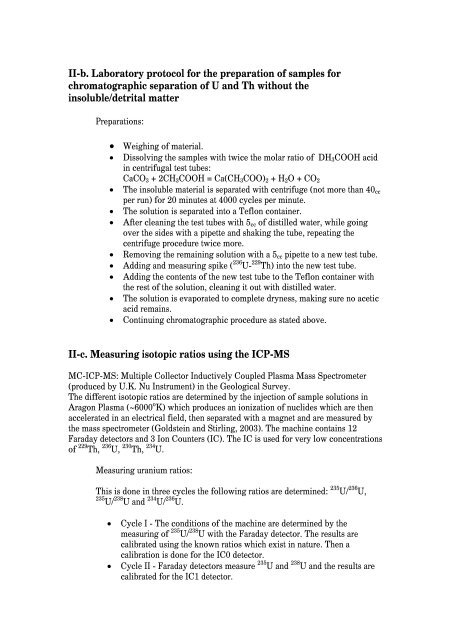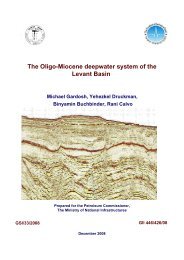tivity on the carmel faul
tivity on the carmel faul
tivity on the carmel faul
Create successful ePaper yourself
Turn your PDF publications into a flip-book with our unique Google optimized e-Paper software.
II-b. Laboratory protocol for <strong>the</strong> preparati<strong>on</strong> of samples for<br />
chromatographic separati<strong>on</strong> of U and Th without <strong>the</strong><br />
insoluble/detrital matter<br />
Preparati<strong>on</strong>s:<br />
• Weighing of material.<br />
• Dissolving <strong>the</strong> samples with twice <strong>the</strong> molar ratio of DH 3 COOH acid<br />
in centrifugal test tubes:<br />
CaCO 3 + 2CH 3 COOH = Ca(CH 3 COO) 2 + H 2 O + CO 2<br />
• The insoluble material is separated with centrifuge (not more than 40 cc<br />
per run) for 20 minutes at 4000 cycles per minute.<br />
• The soluti<strong>on</strong> is separated into a Tefl<strong>on</strong> c<strong>on</strong>tainer.<br />
• After cleaning <strong>the</strong> test tubes with 5 cc of distilled water, while going<br />
over <strong>the</strong> sides with a pipette and shaking <strong>the</strong> tube, repeating <strong>the</strong><br />
centrifuge procedure twice more.<br />
• Removing <strong>the</strong> remaining soluti<strong>on</strong> with a 5 cc pipette to a new test tube.<br />
• Adding and measuring spike ( 236 U- 229 Th) into <strong>the</strong> new test tube.<br />
• Adding <strong>the</strong> c<strong>on</strong>tents of <strong>the</strong> new test tube to <strong>the</strong> Tefl<strong>on</strong> c<strong>on</strong>tainer with<br />
<strong>the</strong> rest of <strong>the</strong> soluti<strong>on</strong>, cleaning it out with distilled water.<br />
• The soluti<strong>on</strong> is evaporated to complete dryness, making sure no acetic<br />
acid remains.<br />
• C<strong>on</strong>tinuing chromatographic procedure as stated above.<br />
II-c. Measuring isotopic ratios using <strong>the</strong> ICP-MS<br />
MC-ICP-MS: Multiple Collector Inductively Coupled Plasma Mass Spectrometer<br />
(produced by U.K. Nu Instrument) in <strong>the</strong> Geological Survey.<br />
The different isotopic ratios are determined by <strong>the</strong> injecti<strong>on</strong> of sample soluti<strong>on</strong>s in<br />
Arag<strong>on</strong> Plasma (~6000 o K) which produces an i<strong>on</strong>izati<strong>on</strong> of nuclides which are <strong>the</strong>n<br />
accelerated in an electrical field, <strong>the</strong>n separated with a magnet and are measured by<br />
<strong>the</strong> mass spectrometer (Goldstein and Stirling, 2003). The machine c<strong>on</strong>tains 12<br />
Faraday detectors and 3 I<strong>on</strong> Counters (IC). The IC is used for very low c<strong>on</strong>centrati<strong>on</strong>s<br />
of 229 Th, 236 U, 230 Th, 234 U.<br />
Measuring uranium ratios:<br />
This is d<strong>on</strong>e in three cycles <strong>the</strong> following ratios are determined: 235 U/ 236 U,<br />
235 U/ 238 U and 234 U/ 236 U.<br />
• Cycle I - The c<strong>on</strong>diti<strong>on</strong>s of <strong>the</strong> machine are determined by <strong>the</strong><br />
measuring of 235 U/ 238 U with <strong>the</strong> Faraday detector. The results are<br />
calibrated using <strong>the</strong> known ratios which exist in nature. Then a<br />
calibrati<strong>on</strong> is d<strong>on</strong>e for <strong>the</strong> IC0 detector.<br />
• Cycle II - Faraday detectors measure 235 U and 238 U and <strong>the</strong> results are<br />
calibrated for <strong>the</strong> IC1 detector.

















